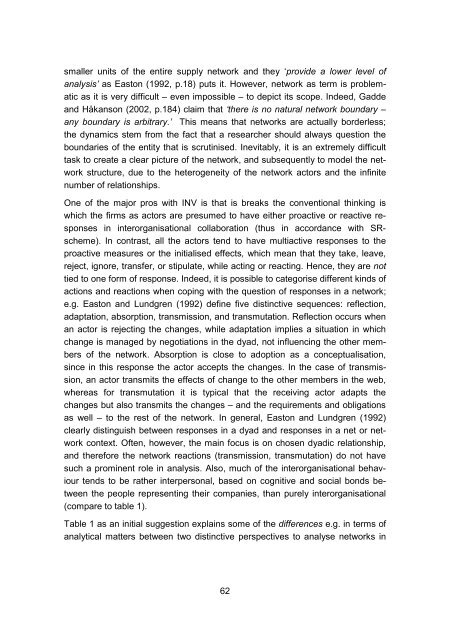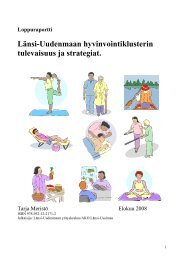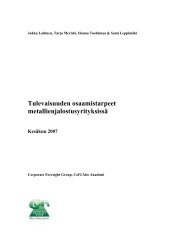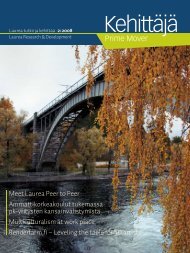849954 sisus
849954 sisus
849954 sisus
Create successful ePaper yourself
Turn your PDF publications into a flip-book with our unique Google optimized e-Paper software.
smaller units of the entire supply network and they ‘provide a lower level of<br />
analysis’ as Easton (1992, p.18) puts it. However, network as term is problematic<br />
as it is very difficult – even impossible – to depict its scope. Indeed, Gadde<br />
and Håkanson (2002, p.184) claim that ‘there is no natural network boundary –<br />
any boundary is arbitrary.’ This means that networks are actually borderless;<br />
the dynamics stem from the fact that a researcher should always question the<br />
boundaries of the entity that is scrutinised. Inevitably, it is an extremely difficult<br />
task to create a clear picture of the network, and subsequently to model the network<br />
structure, due to the heterogeneity of the network actors and the infinite<br />
number of relationships.<br />
One of the major pros with INV is that is breaks the conventional thinking is<br />
which the firms as actors are presumed to have either proactive or reactive responses<br />
in interorganisational collaboration (thus in accordance with SRscheme).<br />
In contrast, all the actors tend to have multiactive responses to the<br />
proactive measures or the initialised effects, which mean that they take, leave,<br />
reject, ignore, transfer, or stipulate, while acting or reacting. Hence, they are not<br />
tied to one form of response. Indeed, it is possible to categorise different kinds of<br />
actions and reactions when coping with the question of responses in a network;<br />
e.g. Easton and Lundgren (1992) define five distinctive sequences: reflection,<br />
adaptation, absorption, transmission, and transmutation. Reflection occurs when<br />
an actor is rejecting the changes, while adaptation implies a situation in which<br />
change is managed by negotiations in the dyad, not influencing the other members<br />
of the network. Absorption is close to adoption as a conceptualisation,<br />
since in this response the actor accepts the changes. In the case of transmission,<br />
an actor transmits the effects of change to the other members in the web,<br />
whereas for transmutation it is typical that the receiving actor adapts the<br />
changes but also transmits the changes – and the requirements and obligations<br />
as well – to the rest of the network. In general, Easton and Lundgren (1992)<br />
clearly distinguish between responses in a dyad and responses in a net or network<br />
context. Often, however, the main focus is on chosen dyadic relationship,<br />
and therefore the network reactions (transmission, transmutation) do not have<br />
such a prominent role in analysis. Also, much of the interorganisational behaviour<br />
tends to be rather interpersonal, based on cognitive and social bonds between<br />
the people representing their companies, than purely interorganisational<br />
(compare to table 1).<br />
Table 1 as an initial suggestion explains some of the differences e.g. in terms of<br />
analytical matters between two distinctive perspectives to analyse networks in<br />
62








